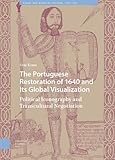The Portuguese Restoration of 1640 and Its Global Visualization : Political Iconography and Transcultural Negotiation / Urte Krass.
Material type: TextSeries: Visual and Material Culture, 1300 –1700 ; 47Publisher: Amsterdam : Amsterdam University Press, [2023]Copyright date: ©2023Description: 1 online resource (508 p.)Content type:
TextSeries: Visual and Material Culture, 1300 –1700 ; 47Publisher: Amsterdam : Amsterdam University Press, [2023]Copyright date: ©2023Description: 1 online resource (508 p.)Content type: - 9789048551750
- Art -- Political aspects -- History
- Art -- Political aspects -- Portugal -- History -- 17th century
- Art and Material Culture
- Early Modern Studies
- History, Art History, and Archaeology
- ART / History / Renaissance
- Global art history, political iconography, Early Modern History, Portuguese Restoration, visual studies, political history
- 709.469 23/eng/20230816
- N7126 .K73 2023
- online - DeGruyter
| Item type | Current library | Call number | URL | Status | Notes | Barcode | |
|---|---|---|---|---|---|---|---|
 eBook
eBook
|
Biblioteca "Angelicum" Pont. Univ. S.Tommaso d'Aquino Nuvola online | online - DeGruyter (Browse shelf(Opens below)) | Online access | Not for loan (Accesso limitato) | Accesso per gli utenti autorizzati / Access for authorized users | (dgr)9789048551750 |
Frontmatter -- Table of Contents -- List of Illustrations -- Acknowledgments -- Introduction -- 1. Signs, Miracles, and Conspiratorial Images -- 2. The Lisbon Miracle of the Crucifix (1 December 1640) -- 3. The New King’s Oath (15 December 1640) -- 4. Acclamations -- 5. Lisbon -- 6. Images in Diplomatic Service -- 7. The Imaculada as Portugal’s Patroness -- 8. The Funeral Apparatus of John IV (November 1656) -- 9. The Drawings in the Treatise of António de São Thiago (Goa 1659) -- 10. Ivory Good Shepherds as Visualizations of the Portuguese Restoration -- Conclusion -- Bibliography -- Index
restricted access online access with authorization star
http://purl.org/coar/access_right/c_16ec
The Portuguese Restoration of 1640 ended the dynastic union of Portugal and Spain. This book pioneers in reconstructing the global image discourse related to the event by bringing together visualizations from three decades and four continents. These include paintings, engravings, a statue, coins, emblems, miniatures, a miraculous crosier and other regalia, buildings, textiles, a castrum doloris, drawings, and ivory statues. Situated within the academic field of visual studies, the book interrogates the role of images and depictions before, during, and after the overthrow and how they functioned within the intercontinental communication processes in the Portuguese Empire. The results challenge the conventional notion of center and periphery and reveal unforeseen entanglements as well as an unexpected agency of imagery from the remotest regions under Portuguese control. The book breaks new ground in linking the field of early modern political iconography with transcultural art history and visual studies.
Mode of access: Internet via World Wide Web.
In English.
Description based on online resource; title from PDF title page (publisher's Web site, viewed 06. Mrz 2024)


